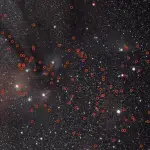Key Takeaways:
- Scientists debated the origin of Mars’ moons Phobos and Deimos. Asteroids and impact origin theories have issues.
- New study suggests Phobos might be a captured comet based on light reflection analysis.
- This could mean Phobos and Deimos were once a single comet broken apart by Mars’ gravity.
- If true, Phobos would be the first “comet moon” around a terrestrial planet.
- More studies and sample collection by the MMX mission are needed to confirm the comet theory.
Based on previously unreleased images, a new preprint study suggests that Phobos, the moon of Mars, may actually be a comet, or at least a part of one, that was gravitationally captured by the Red Planet long ago.
Scientists have been baffled by the origins of Phobos and its twin, Deimos, for years. Because the moons’ chemical makeup resembles that of some rocks in the main asteroid belt between Mars and Jupiter, some have theorized that the moons are once-asteroids drawn in by Mars’ gravity. However, computer models simulating this capture process have not been able to replicate the pair’s near-circular paths around Mars.
Another theory claims that a massive impact, similar to the one that formed our moon, ripped the two from the Red Planet; however, this theory is unlikely as well because Phobos differs chemically from Mars.
One of the goals of the Japan Aerospace Exploration Agency’s Martian Moons eXploration (MMX) mission, which is scheduled for launch in 2026, is to precisely determine how Phobos originated. Lead author of the new paper and professor of astronomy at Paris Cité University Sonia Fornasier is an instrument scientist for the MMX mission. Fornasier discovered unreleased images while she and other scientists were examining pictures to adjust the spacecraft’s planned path.
These 300 odd images beautifully capture the features of Phobos. They were taken by high-resolution cameras on board the Mars Express spacecraft, a European Space Agency (ESA) orbiter that has been studying Mars and its moons since 2003. This includes the largest landmark on Phobos, the 9-kilometer-wide (5.6-mile-wide) Stickney Crater.
Using the photos, Fornasier and her associates examined the amount of sunlight that Phobos reflected at various angles. They were able to ascertain how much light Phobos reflected when the sun was directly in front of it or at an angle that was offset thanks to a method known as photometry.

It was found by the researchers that Phobos’s surface did not reflect light evenly. Certain areas were very reflective, such as the crater’s northeastern rim. However, the team’s analysis also revealed that when the sun was directly overhead, Phobos’s surface generally appeared noticeably brighter. An opposition surge is a phenomenon that is common to many objects in the solar system that lack air. The researchers also discovered that Phobos had a porous surface, much like sand. As a result, the team hypothesized that a thick layer of grooved dust, whose shadows disappeared in direct sunlight, might be covering the moon’s surface.
These two characteristics also apply to comets in the Jupiter family, which are comets whose orbits are modified gravitationally by Jupiter. Among them is the “rubber ducky” Comet 67P, which was closely examined in 2016 by ESA’s Rosetta mission. The photometric characteristics of Phobos actually matched Comet 67P almost exactly. Thus, the team came to the conclusion that Phobos might be a comet that Mars had captured.
The results of the study also have significance for Deimos. Fornasier pointed out that Deimos might have been a comet as well if Phobos had ever been one. Her team actually hypothesizes that the two moons might have once been united as a single bilobed comet that was trapped and ultimately split apart by Mars’ gravity based on the study. In other words, Mars’ twin moons may actually be two halves of a single whole.
“If the Martian satellites are indeed captured comets, this implies that comets may be captured also by telluric [terrestrial] planets,” Fornasier added. She said that the Kuiper Belt, the doughnut-shaped area that surrounds the solar system and is the likely parent of many comets, is where some moons of gas giants like Saturn most likely developed. Phobos, however, may be the first “comet moon” for terrestrial planets, as astronomers haven’t yet discovered any.
However, there are issues with the comet interpretation as well. Certain photometric parameters are not consistent with comets, such as the fraction of scattered light. Dynamical simulations, which take into account the movements of celestial objects like Mars and Phobos, will assist the team in determining the probability of a comet entrapment, according to Fornasier. Ultimately, though, the best chance of clearing up the hazy beginnings of this enigmatic moon is likely the MMX program, which will physically sample portions of Phobos.
The new study is forthcoming in the journal Astronomy and Astrophysics, and available on the preprint server arXiv.


